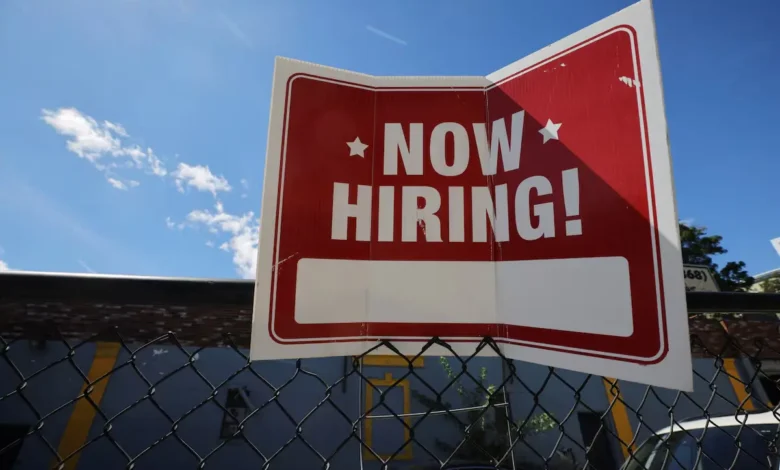A Reality Check for America’s Job Market After August’s Labor Market Data

The numbers don’t lie, and frankly, they’re not pretty. August’s employment report landed with the kind of thud that makes you want to double-check the calculations. The U.S. economy managed to squeeze out just 22,000 new jobs last month—a figure so anemic it makes you wonder if someone forgot to carry the one. To put this in perspective, economists were expecting around 75,000 jobs, which wasn’t exactly ambitious to begin with.
But here’s the kicker: the unemployment rate climbed to 4.3%, marking the highest level we’ve seen since 2021. That might not sound catastrophic until you realize we’re talking about 7.4 million Americans actively looking for work. These aren’t just statistics on a government spreadsheet, they’re real people dealing with real consequences.
The Numbers Behind the Numbers
What makes this report particularly sobering is the pattern it continues. Over the past three months, job creation has averaged fewer than 30,000 positions. That’s not a hiring slowdown; that’s practically a hiring freeze with a pulse. Manufacturing alone shed 12,000 jobs in August, marking the fourth consecutive month of losses in that sector. When you factor in the downward revisions, June actually lost 13,000 jobs, the first monthly decline since 2020, the picture becomes even starker.
The few bright spots feel like finding quarters in the couch cushions when you need to pay rent. Healthcare added 31,000 jobs, and social assistance contributed another 16,000. But here’s the reality check: healthcare represents just 15% of total employment. For the other 85% of the workforce, opportunities are increasingly scarce.
Young workers are getting hit particularly hard. The unemployment rate for 16-to-24-year-olds jumped to 10.5% in August, the highest level in nearly four years. Fresh graduates aren’t just competing with each other anymore—they’re fighting for scraps in a market that has fundamentally shifted.
The Broader Economic Picture
This isn’t happening in a vacuum. The Federal Reserve has kept interest rates elevated, citing concerns about inflation, while companies grapple with economic uncertainty and policy changes. The result is what economists politely call a “low-hire, low-fire environment”—corporate speak for “nobody’s moving anywhere.”
For the first time in more than four years, there are now fewer job openings than job seekers. That’s a complete reversal from the pandemic-era labor shortage when workers had their pick of opportunities. The tables have turned, and they’ve turned hard.
Layoff announcements tell another part of the story. August saw 85,979 planned layoffs, up from 62,075 in July. Outside of the pandemic, this represents the worst August for layoff announcements since the Great Recession. Companies aren’t just being cautious, they’re actively cutting costs and preparing for leaner times ahead.
The Regional and Demographic Reality
The pain isn’t distributed equally. While the overall unemployment rate sits at 4.3%, that number masks significant disparities. Black unemployment remains elevated at 7.5%, nearly double the rate for white workers at 3.7%. Hispanic unemployment sits at 5.3%, while Asian unemployment is at 3.6%. These gaps aren’t new, but they’re becoming more pronounced as opportunities become scarcer.
Long-term unemployment is creeping up too. About 1.9 million Americans have been jobless for 27 weeks or more, that’s more than half a year of searching, networking, and dealing with rejection. These workers face the double burden of an increasingly competitive market and the stigma that unfortunately still accompanies extended unemployment.
The labor force participation rate, at 62.3%, has declined by 0.4 percentage points over the year. Translation: more people are giving up on finding work altogether. When you’re discouraged enough to stop looking, you don’t even count in the unemployment statistics anymore.
What September Typically Brings
Here’s where things get interesting. September has traditionally been one of the strongest hiring months of the year. Companies shake off their summer lethargy, budgets get finalized for Q4 initiatives, and there’s usually a surge in job postings as businesses try to get new hires settled before the year-end sprint.
This “September Surge” isn’t just HR folklore, it’s backed by real data. Historically, September sees a significant uptick in both job postings and hiring activity compared to the slower summer months. Companies use this window to backfill key roles that were delayed over vacation season and to position themselves for the final quarter push.
The phenomenon occurs for several practical reasons. Summer hiring often slows due to vacations, budget delays, and the general pace of business during warmer months. September represents a fresh start, new fiscal quarters for many companies, return from summer schedules, and a sense of urgency to get critical positions filled before the holiday season creates another hiring lull.
Different sectors experience this surge differently. Sales and business development roles typically see increased demand as companies focus on year-end revenue targets. Customer success and support positions often open up as businesses prepare for Q4 client onboarding. Tech roles, despite recent challenges, still see movement as companies finalize their technology initiatives for the year.
How to Prepare for the September Surge Window
If you’re currently in the job market, now is the time to position yourself for whatever opportunities September might bring. The fundamentals matter more than ever when competition is fierce.
Start with your resume and make sure it’s not just current, but compelling. In a market where hiring managers can afford to be picky, your application materials need to stand out immediately. Consider using tools like InterviewPal’s AI cover letter generator to craft targeted, professional letters that speak directly to each role you’re pursuing. Generic cover letters are career suicide in this environment.
Your LinkedIn profile deserves equal attention. It’s often the first impression you’ll make with recruiters and hiring managers. Make sure your headline clearly communicates your value proposition, your summary tells a compelling story, and your experience section includes quantifiable achievements rather than just job descriptions.
Networking becomes absolutely critical when job openings are scarce. Many positions never make it to public job boards—they’re filled through internal referrals and professional connections. Start reaching out to former colleagues, industry contacts, and even acquaintances who might have insights into their company’s hiring plans.
Interview Preparation That Actually Works
The interview process has become more rigorous as companies can afford to be selective. You can’t wing it anymore. Use resources like InterviewPal’s question bank to practice responses to both common and industry-specific questions. The goal isn’t to memorize scripts, but to develop thoughtful, authentic responses that demonstrate your value.
Behavioral questions are increasingly common, so prepare specific examples that illustrate your problem-solving abilities, leadership skills, and adaptability. Use the STAR method (Situation, Task, Action, Result) to structure your responses, but make sure they feel conversational rather than robotic.
Research the company thoroughly. In a competitive market, showing genuine interest in and knowledge of the organization can set you apart. Understand their recent news, challenges, and strategic priorities. Be prepared to explain not just why you want the job, but how you can help solve their specific problems.
Where to Focus Your Search
While September may bring increased activity, smart job seekers are casting a wide net and thinking strategically about where opportunities might emerge.
Remote job boards like Jobspresso have become increasingly valuable as companies continue to embrace flexible work arrangements. The shift to remote work has opened up opportunities that weren’t available when geography limited your options. Companies in expensive metro areas are increasingly willing to hire talented professionals from lower-cost regions.
Don’t overlook smaller companies and startups. While big corporations are tightening their belts, smaller organizations often move faster and have fewer layers of approval for new hires. They may also be more willing to take chances on candidates who don’t fit the traditional mold but bring valuable skills and enthusiasm.
Healthcare, despite being one of the few bright spots in hiring, still offers opportunities beyond direct patient care. Health technology, medical administration, and healthcare support roles are growing as the industry continues to evolve.
The Skills That Matter Now
The job market has become increasingly skills-focused rather than credential-focused. Employers are looking for specific capabilities that can immediately impact their business. Artificial intelligence literacy isn’t just nice to have anymore—it’s becoming expected across many roles. You don’t need to be a data scientist, but understanding how AI tools can enhance productivity and decision-making is increasingly valuable.
Digital marketing skills remain in demand as companies continue to invest in online customer acquisition. Project management capabilities are highly sought after as organizations try to do more with less. Customer service and relationship management skills are premium assets as companies focus on retaining existing business rather than expensive new customer acquisition.
Financial analysis and data interpretation skills are becoming universal requirements as businesses become more metrics-driven. Even roles that weren’t traditionally analytical now require comfort with spreadsheets, basic statistics, and data-driven decision making.
The Psychological Game
Looking for work in this environment can be emotionally exhausting. Rejection rates are higher, response times are longer, and the process feels more impersonal than ever. It’s important to maintain perspective and develop coping strategies.
Set realistic expectations about timeline and response rates. If you’re getting one interview for every 20 applications, that might actually be normal in the current market rather than a reflection of your qualifications. Treat job searching like a numbers game while still maintaining quality in your applications.
Build rejection resilience. Every “no” gets you closer to the “yes,” but only if you learn from the experience and continue improving your approach. Ask for feedback when possible, but don’t take silence personally, hiring managers are overwhelmed too.
Maintain your routine and mental health. Job searching can become all-consuming, but burning out won’t help your chances. Set boundaries around your search activities, maintain social connections, and engage in activities that give you energy rather than drain it.
Looking Beyond September
While September might offer a temporary boost in opportunities, the underlying job market challenges aren’t going away quickly. The combination of economic uncertainty, technological change, and demographic shifts means we’re likely looking at a prolonged period of tight hiring conditions.
This reality requires a different approach to career management. Rather than just looking for the next job, start thinking about building a portfolio of skills and experiences that will remain valuable regardless of market conditions. Continuous learning isn’t just professional development anymore,it’s career insurance.
Consider developing multiple income streams where possible. The gig economy, consulting work, and freelance opportunities can provide both financial stability and skill development while you navigate the traditional job market.
Build your professional brand beyond just job searching. Share industry insights on LinkedIn, contribute to professional discussions, and position yourself as someone who adds value to every conversation. When opportunities do arise, you want to be top of mind.
Conclusion
The August jobs report confirms what many job seekers have been experiencing firsthand: this is a tough market that requires a strategic, persistent approach. The traditional September surge may still materialize, but it won’t solve the underlying challenges facing American workers.
Success in this environment requires preparation, patience, and a willingness to adapt your strategy based on market realities. The fundamentals of job searching haven’t changed, networking, skill development, and persistence still matter. But the execution needs to be sharper, more targeted, and more professional than ever.
The job market will eventually recover, as it always does. But the workers who thrive during this difficult period will be those who use the time to build stronger skills, broader networks, and more resilient career strategies. The September surge might give you opportunities, but what you do with them will determine your success.
For now, focus on what you can control: your skills, your network, your application materials, and your persistence. The numbers may be discouraging, but they don’t define your individual potential. In a market where every opportunity matters, being prepared when luck meets opportunity becomes the difference between continued searching and career advancement.




